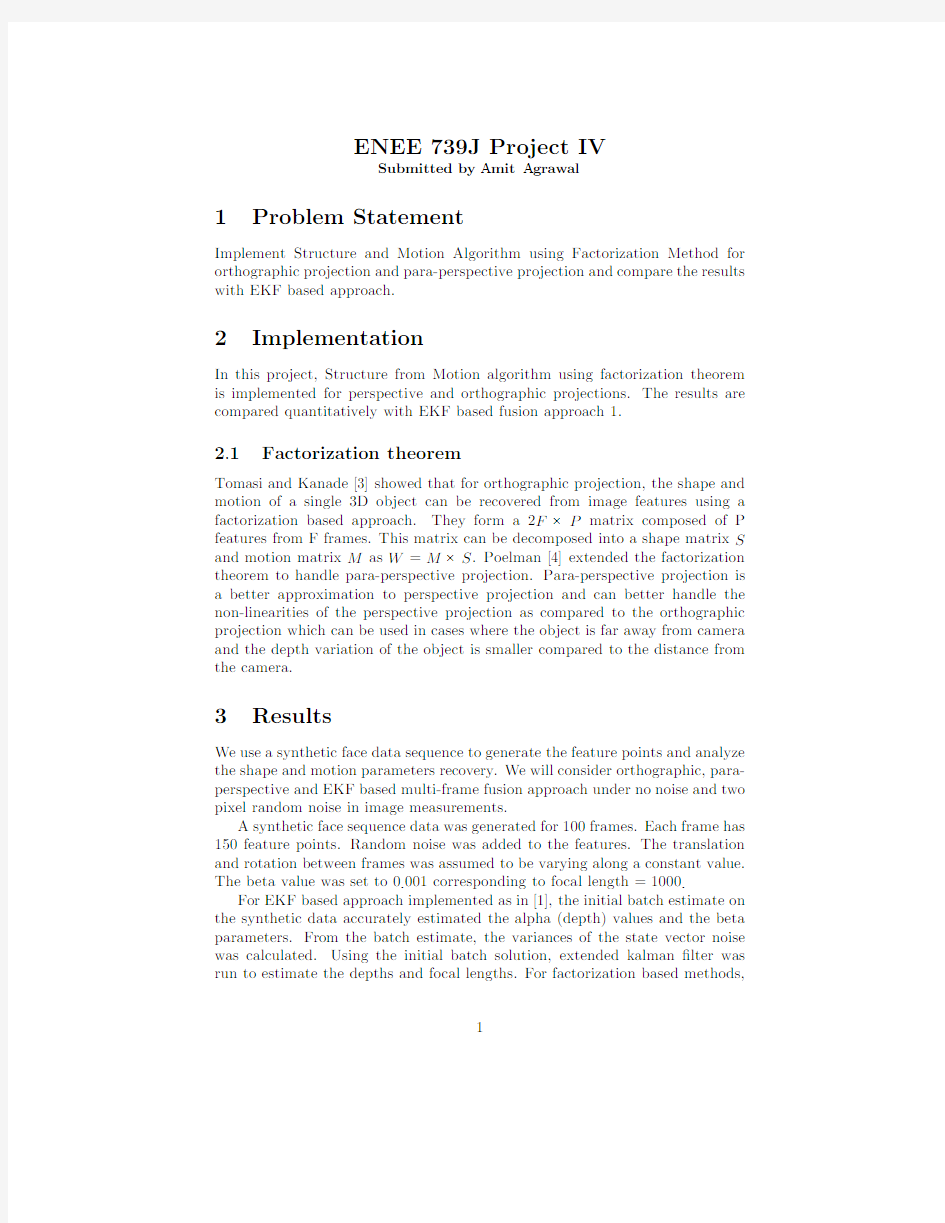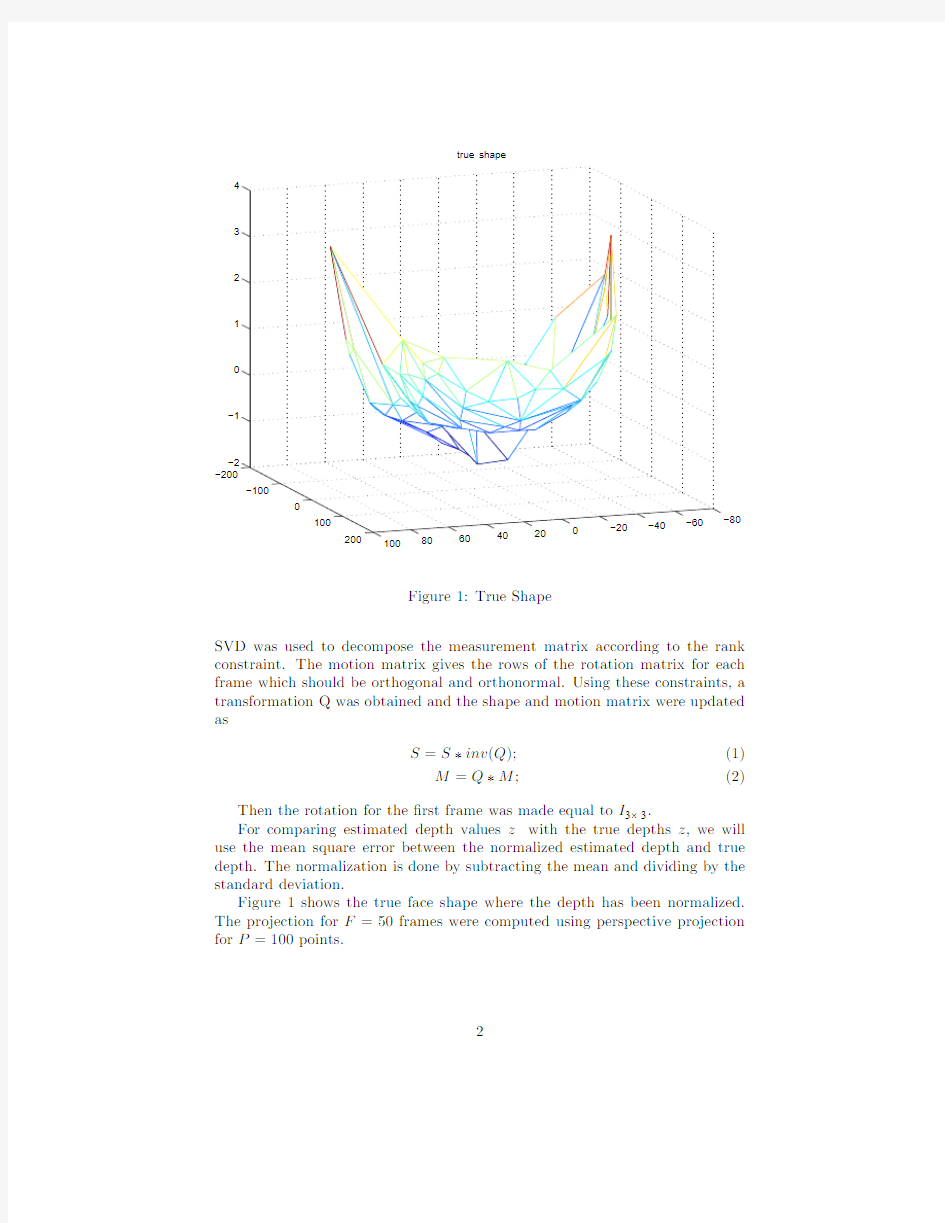1 Problem Statement ENEE 739J Project IV Submitted by Amit Agrawal Implement Structure and


ENEE739J Project IV
Submitted by Amit Agrawal
1Problem Statement
Implement Structure and Motion Algorithm using Factorization Method for orthographic projection and para-perspective projection and compare the results with EKF based approach.
2Implementation
In this project,Structure from Motion algorithm using factorization theorem is implemented for perspective and orthographic projections.The results are compared quantitatively with EKF based fusion approach1.
2.1Factorization theorem
Tomasi and Kanade[3]showed that for orthographic projection,the shape and motion of a single3D object can be recovered from image features using a factorization based approach.They form a2F×P matrix composed of P features from F frames.This matrix can be decomposed into a shape matrix S and motion matrix M as W=M×S.Poelman[4]extended the factorization theorem to handle para-perspective projection.Para-perspective projection is a better approximation to perspective projection and can better handle the non-linearities of the perspective projection as compared to the orthographic projection which can be used in cases where the object is far away from camera and the depth variation of the object is smaller compared to the distance from the camera.
3Results
We use a synthetic face data sequence to generate the feature points and analyze the shape and motion parameters recovery.We will consider orthographic,para-perspective and EKF based multi-frame fusion approach under no noise and two pixel random noise in image measurements.
A synthetic face sequence data was generated for100frames.Each frame has 150feature points.Random noise was added to the features.The translation and rotation between frames was assumed to be varying along a constant value. The beta value was set to0.001corresponding to focal length=1000.
For EKF based approach implemented as in[1],the initial batch estimate on the synthetic data accurately estimated the alpha(depth)values and the beta parameters.From the batch estimate,the variances of the state vector noise was https://www.360docs.net/doc/e011551428.html,ing the initial batch solution,extended kalman?lter was run to estimate the depths and focal lengths.For factorization based methods,
1
Figure1:True Shape
SVD was used to decompose the measurement matrix according to the rank constraint.The motion matrix gives the rows of the rotation matrix for each frame which should be orthogonal and https://www.360docs.net/doc/e011551428.html,ing these constraints,a transformation Q was obtained and the shape and motion matrix were updated as
S=S?inv(Q);(1)
M=Q?M;(2) Then the rotation for the?rst frame was made equal to I3×3.
For comparing estimated depth values z with the true depths z,we will use the mean square error between the normalized estimated depth and true depth.The normalization is done by subtracting the mean and dividing by the standard deviation.
Figure1shows the true face shape where the depth has been normalized. The projection for F=50frames were computed using perspective projection for P=100points.
2
Figure2:Estimated Shape:Para-perspective
3.1Test1
Here we have zero noise in the feature points.Note that the features has been generated using perspective projection,so even in zero noise case,there will be errors because the orthographic and para-perspective projection have been used as an approximation to the perspective projection.Figure1shows the true3D shape of the face.
Figure2,34shows the recovered shape using para-perspective projection which is close to the true one and the estimated translation and rotation between frames along with the true values.The errors in depth has been tabulated in Table1.
Figure5,67shows the recovered shape using orthographic projection and the estimated translation and rotation between frames along with the true val-ues.
Figure8,910shows the recovered shape using orthographic projection and the estimated translation and rotation between frames along with the true val-ues.
We observe that in zero noise case,the translation and rotation estimates obtained from EKF are not as good as that from factorization theorems but the
3
4
5
Figure5:Estimated Shape:Orthographic
7
Figure8:Estimated Shape:EKF
8
9
10
Figure11:Estimated Shape:Para-perspective
depth estimate from EKF is better than that obtained from factorization.The translation and rotation estimates obtained from para-perspective projection are closer to the true values as compared to orthographic projection.
3.2Test2
Here we add2pixel random noise to the feature points and estimate the motion and shape.
Figure11,1213shows the recovered shape using para-perspective projection and the estimated translation and rotation between frames along with the true values.The errors in depth has been tabulated in Table1.
Figure14,1516shows the recovered shape using orthographic projection and the estimated translation and rotation between frames along with the true values for2pixel noise.
Figure17,1819shows the recovered shape and the estimated translation and rotation between frames along with the true values using EKF.
Table1shows the mean square error between the normalized estimated depth values and the normalized true depth values for di?erent approaches and noise values.We observe that the fusion using EKF approach gives the best result
11
12
13
Figure14:Estimated Shape:Orthographic
15
Figure17:Estimated Shape:EKF
16
17
18
Table1:Mean square error between normalized estimated depth and normalized true depth
Method Noise=0Noise=2pix
Ortho0.028800.033
Para0.010400.040
EKF0.002840.006
for depth estimates as it optimally combines the measurements to estimate depth.However,the translation and rotation estimates are less accurate as compared to factorization method.Also,the estimates obtained using para-perspective model are better than those obtained using orthographic model as para-perspective is a better approximation to the perspective projection. References
[1]Azarbayejani A,Pentland AP,”Recursive Estimation of Motion,Structure
and Focal Length”,IEEE Trans.on PAMI,Vol.17,NO.6,June1995 [2]Broida TJ,Chandrashekhar S,Chellappa R,”Recursive3-D Motion Esti-
mation from a Monocular Image Sequence”,Signal and Image Processing Institute,USC,CA
[3]Tomasi C,Kanade T,”Shape and Motion from Image Streams:A factor-
ization Method”,Cornell TR92-1270and CMU-CS-92-104
[4]Poelman CJ,Kanade T,”A Paraperspective Factorization Method for Shape
and Motion Recovery”,Dec1993,CMU-CS-93-219
19
